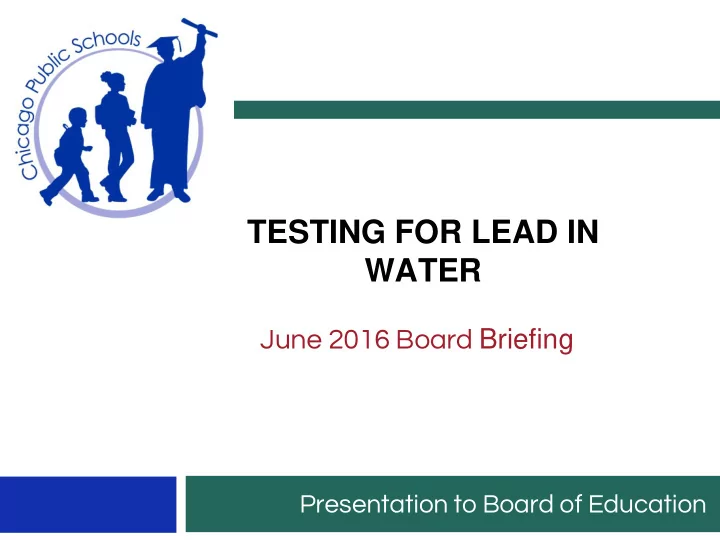

TESTING FOR LEAD IN WATER June 2016 Board Briefing Presentation to Board of Education
Water Testing Overview 2 • In light of National events that brought increased attention to the issue of water quality, the City of Chicago announced several additional precautionary measures that will be added to the City’s water testing protocol, continuing the City’s track record of exceeding current state and federal regulations as well as industry standards • As part of this announcement, Chicago Public Schools (CPS) began testing the water for levels of lead from all schools across the district. Our top priority is the health and safety of our students and staff, and this testing was initiated out of an abundance of caution to ensure the water in our schools is safe. • Lead comes from many different sources: paint, soil, consumer products, and water, to name a few. • Drinking water in Chicago comes from Lake Michigan and the Great Lakes system is the largest source of fresh surface water in the world. Chicago’s water supply is free of lead when it leaves the treatment plant. However, lead can be found in some interior plumbing fixtures and materials, and lead found in tap water usually comes from the corrosion of these items. • For testing, the U.S. EPA has established 15 ppb (parts per billion) as the action level
Wat ater Test sting g to to Dat ate 3 ▪ CPS’ goal is to test all schools for lead in water, starting with those built before 1986 that also have pre-K programs ▪ CPS portfolio consists of 526 campuses housed in 824 buildings; 470 school campuses were built prior to 1986 ▪ The first round of testing consists of 324 schools. Testing is complete at these schools as of today. The schools were selected based on the following criteria: • Built before 1986: In 1986, the U.S. EPA banned lead as a construction material for use in water supply systems • Existing pre-k program: Lead exposure is more harmful to children brain development between the ages of 0 to 6 ▪ In the fall, CPS will test the remaining schools that fall into the following categories: • Elementary schools without pre-k programs built before 1986 • High Schools built before 1986 • Elementary schools built after 1986 • High schools built after 1986
Water Testing Results to Date 4 ▪ Combining lessons learned from the pilot program and assistance from the Dept. of Water Management, CPS developed best practice for testing which include: • The building must be operational the day before samples are taken • The building water system is not used for 8 hours prior to the samples taken • Sequential sampling is used which requires 5 250ml of water are drawn from each fixture tested • Fixtures selected are based on recommended drinking sources of water in a school o Drinking Fountains o Kitchen sinks used in food preparation o All sinks and water fountains in pre-k and kindergarten rooms o Faculty lounge sinks ▪ Testing Results as of June 22 nd • Schools Tested o 324 of 324 schools have been tested o Results for 98 of the schools have been reported o Of the 98, 30 schools have above action levels reported • Sample Draws o 28,064 samples have been collected o Results for 7,660 samples have been reported o 137 samples are above action level. • Fixtures Tested o 5,785 fixtures tested o 1,704 results for these fixtures have been reported o 67 fixtures have action levels
Remediation Plan 5 ▪ Critical first step after notification is to turn off all access to fixtures with actionable levels. • Asset team is alerted to go to the school to shut off the fixture • If a fixture is located in the kitchen, Food Service is notified. At this point, Food Service decides whether to serve a hot lunch or a bag lunch • Food Service supplies water coolers to the schools as needed ▪ After the school’s fixtures are taken off line an architect or engineer is sent to the school to: • Gather information about the specific plumbing fixture and its use • Develop a scope of work specifically tailored to each fixture/school ▪ A scope of work is developed which generally includes a series of flushing and retesting until no action levels are detected. The steps are as follows: • Flush the system per U.S. EPA guidelines. Retest the fixture. If negative no further action is required. • If the retest is positive, remove the faucet at sink or bubbler at drinking fountain and retest. If the retest is negative replace the faucet of bubbler and no further a. • If the retest is positive, remove and install a shut off valve at the supply pipe at the wall. Test the water at the wall. If it comes back negative, the fixture is the source of the lead in water. Evaluate whether fixture parts can be replaced or the fixture has to be replaced. Retest. • If the water at the wall is above action level, remove the branch line back to the plumbing riser and fixture. If the retest is negative replace the branch lines, faucet or bubbler and no further action is necessary. Retest the fixture, if the retest comes back negative no further action is required. • If the retest is positive, further investigation and destructive testing is needed which may result in a large capital project. ▪ All fixtures identified with being a source of lead in the water will be retested at the end of the corrective work. ▪ All corrective work for the 324 schools tested is scheduled to be completed over the summer break.
Recommend
More recommend